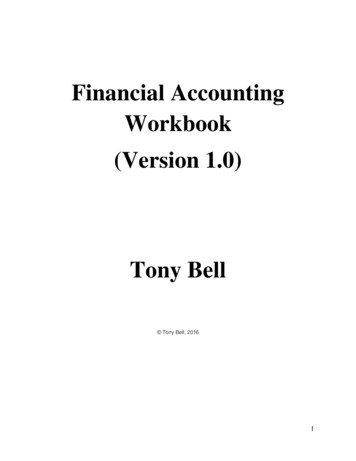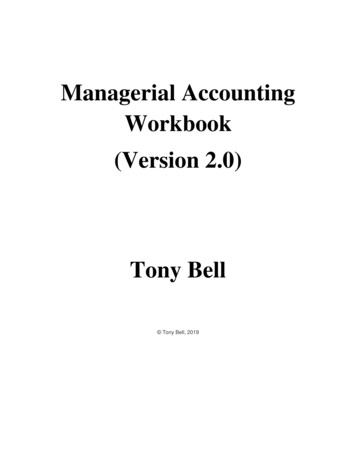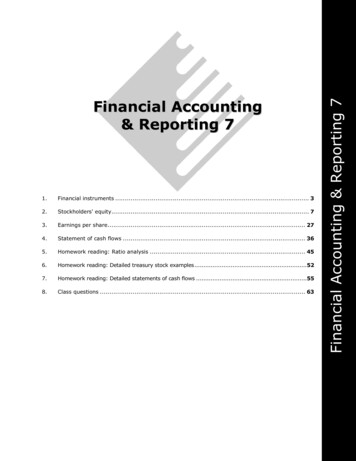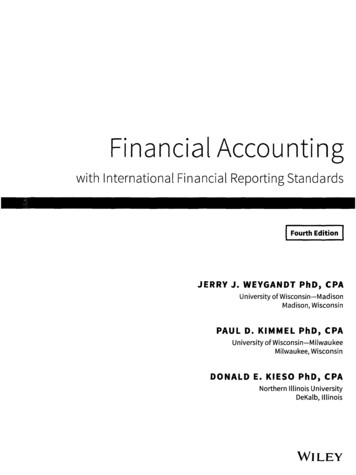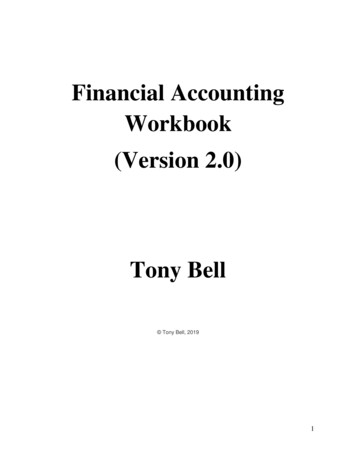
Transcription
Financial AccountingWorkbook(Version 2.0)Tony Bell Tony Bell, 20191
Table of ContentsA Note to Instructors . 3Module 1: Introduction to the Financial Statements . 4Module 2: Recording Transactions . 14Module 3: Adjusting Entries and Closing Entries . 23Module 4: Cash . 32Module 5: Receivables . 37Module 6: Inventory Purchases, Sales, Returns and Discounts . 45Module 7: Cost of Inventory (FIFO, LIFO, Weighted Average, and Specific Identification) . 52Module 8: Property, Plant and Equipment . 57Module 9: Liabilities . 63Module 10: Equity . 69Module 11: Statement of Cash Flows . 74Module 12: Ratios and Financial Statement Analysis . 832
A Note to InstructorsI hope you find this workbook useful, I just want to point out three key features:1.) This book is totally free to you and your students. Feel free to copy it or post it to yourcourse website and feel free to share it with colleagues.2.) Although I am widely distributing a PDF file, I have gone to great effort to make a fullyeditable Word version of this document. Please contact me if you’d like to have a copyof the Word version. You can edit any of these problems to better fit in your class orsimply copy and paste an entire problem into an assignment or test, with the attribution“Source: accountingworkbook.com”, or “Adapted from: accountingworkbook.com”.3.) Every problem in this workbook has a video walkthrough available athttp://accountingworkbook.com. I suspect the true value in this book lies in the videowalkthroughs, as it will be useful for homework and particularly useful for “flipping theclassroom”.Please let me know if you would like to see additional question-types or topics included inthe future. I intend to add to this book frequently based on your input. Also, any feedbackyou can provide (particularly student feedback) would be greatly appreciated.Please note, you do not have my permission to use this for a commercial purpose, nor do youhave permission to recreate the videos found at http://accountingworkbook.com. Send me anemail if you have any questions about use or attribution.Thanks for checking out this workbook, and I hope you’ll have a look at the companionwebsite: http://accountingworkbook.com !Tony Belltbella@gmail.com3
Module 1: Introductionto the FinancialStatements4
1-1A – Accounting EquationFill in the missing information below:Shareholders’ EquityAssetsLiabilitiesBusiness #1 181,000 212,000Business #275,00036,000Business #330,00021,000Business #425,000(10,000)** Business #4’s equity is in an accumulated deficit position.1-1B – Accounting EquationFill in the missing information below:Business #1Shareholders’ EquityAssetsLiabilities 80,000 60,0001,100,000Business #21,250,000Business #375,000Business #452,00048,000(9,000)** Business #4’s equity is in an accumulated deficit position.5
1-2A – Account ClassificationEach of the following accounts is either an Asset (A), Liability (L), Shareholders’ Equity (SE),Revenue (Rev), Expense (Exp) or Dividend (Div) account.Mark the first blank with the appropriate classification – A, L, SE, Rev, Exp or Div.If you have identified an item as either an Asset or Liability, mark the second blank as “C” if theitem is current, or “LT” for Long-Term.A/L/SE/Rev/Exp/DivC?Long-term investmentsAccounts receivableConsulting revenueRent revenueComputerMortgage payableSalaries payableCashSupplies expenseRetained earningsTemporary investmentsAccounts payableIncome tax expenseCarSalaries expenseUtilities expenseLandInventoryBuildingInterest expenseBank loan payableCommon sharesSupplies6
1-2B – Account ClassificationEach of the following accounts is either an Asset (A), Liability (L), Shareholders’ Equity (SE),Revenue (Rev), Expense (Exp) or Dividend (Div) account.Mark the first blank with the appropriate classification – A, L, SE, Rev, Exp or Div.If you have identified an item as either an Asset or Liability, mark the second blank as “C” if theitem is current or “LT” for Long-Term.A/L/SE/Rev/Exp/DivC?Car loanSoftware expenseWages expenseOffice furnitureLong-term investmentsInventorySmall toolsAccounts payableRetained earningsAccounts receivablePropertyRepair revenueMaintenance expenseInterest expenseSalaries payableSubscription revenueCommon sharesTelephone equipmentSales revenueIncome tax expenseMortgage payableCashTelephone expense7
1-3A – Basic Financial StatementsSherry’s Shuttles is a bus company offering rides to outdoor adventurers. In the summer, shecaters to mountain bikers and in winter to skiers. Sherry’s company has the following accountbalances, all on December 31, 2024 and for the year then ended unless otherwise noted:Wages payable 1,600Insurance expenseDividends3,000Telephone expenseCash5,000Equipment, net30,000Bank loan45,000Retained earnings (January 1, 2024)10,000Common shares (Jan 1, 2024)Accounts payableBuildings, net60,0002,200100,000 4,000400Accounts receivable1,000Shuttle revenue69,300Office suppliesFuel expense11,000Wages expense30,0002,000Utilities expense1,200Depreciation expense500The company did not issue or repurchase any common shares during the year.Required:a.) Prepare an income statement for the year ended December 31, 2024.b.) Prepare a statement of changes in equity for the year ended December 31, 2024.c.) Prepare a balance sheet as at December 31, 2024.d.) Based on your financial statements, compute:i. The current ratioii. The debt ratioiii. The equity ratio8
1-3B – Basic Financial StatementsJohn’s Jungle Gyms is an indoor play area for children. Parents bring their toddlers to play ongerm-covered slides, ladders, ball pits, monkey bars and other pieces of equipment. Thefollowing account balances relate to the company’s October 31, 2024 month end financialstatements:Retained earnings (Oct. 1, 2024)Cash 118,09014,000Admission revenue 25,000Mortgage178,000225,000Accounts payable5,000Buildings, netWages payable2,000Wages expense6,000Repair expense1,500Insurance expense3,000Accounts receivable500Common shares (Oct. 1, 2024)Dividends200Equipment, netDepreciation expense2,600Utilities expense1075,000300There were no common shares issued or repurchased during the month.Required:a.) Prepare an income statement for the month ended October 31, 2024.b.) Prepare a statement of changes in equity for the month ended October 31, 2024.c.) Prepare a balance sheet as at October 31, 2024.d.) Based on your financial statements, compute:i. The current ratioii. The debt ratioiii. The equity ratio9
1-4A – More Complex Financial StatementsIndustrial Relations Ltd. offers mediation services for unionized companies. When there is acontract dispute between a union and company management, often the two sides require anoutside consultant to assist in the negotiations – Industrial Relations Ltd. fills this role. Thefollowing account balances relate to the company’s June 30, 2024 year-end financial statements:Accumulated depreciation - buildingsWages expenseEquipmentSuppliesDepreciation expenseConsulting revenueBuildings 12,00035,0007,000Travel expense 6,000Retained earnings (July 1, 2023)34,900Accumulated depreciation - equipment1,500500Supplies expense3,5002,500Interest expense3,00088,000125,000Common shares (July 1, 2023)Mortgage payable10060,000Cash3,000Accounts receivable1,000Dividends6,000Notes payable5,000Accounts payable2,000Income tax expense11,000Notes: There were no common shares issued or repurchased during the year. The current portion of the mortgage payable was 8,000.Required:a.) Prepare an income statement for the year ended June 30, 2024.b.) Prepare a statement of changes in equity for the year ended June 30, 2024.c.) Prepare a balance sheet as at June 30, 2024.d.) Based on your financial statements, compute:i. The current ratioii. The debt ratioiii. The equity ratio10
1-4B – More Complex Financial StatementsRagequit PC Repair specializes in computer equipment repair following incidents of “gamerrage”. After losing online games some gamers enter a fit of irrational rage, and break gamingcontrollers, monitors, notebook computers, mice, keyboards and televisions*. This rage has beenlucrative for the Ragequit PC Repair. The following account balances relate to the company’sNovember 30, 2024 year-end financial statements:Bank loan payable4,000Income tax expenseInterest expense250Repair revenueDividends700Accounts payableCommon shares (Dec 1, 2023)Wages expense5038,00020055,000Rent expenseAccounts receivable4008,500100Supplies1,200Accumulated depreciation – tools and equipmentSupplies expense5,000Cash900Tools and Equipment6,000Notes payable800Retained earnings (Dec 1, 2023)500Depreciation expense1,5001,400Notes: There were no common shares issued or repurchased during the year. The current portion of the bank loan payable was 600.Required:a.) Prepare an income statement for the year ended November 30, 2024.b.) Prepare a statement of changes in equity for the year ended November 30, 2024.c.) Prepare a balance sheet as at November 30, 2024.d.) Based on your financial statements, compute:i. The current ratioii. The debt ratioiii. The equity ratio*Like when your opponent (who had unbelievable RNG luck the whole game) top-decks theexact card he needed to beat you, even though you outplayed him, and are clearly smarter andbetter than him. Ridiculous. Hearthstone is for babies.11
1-5A – More Complex Financial Statements (Net Loss and Share Issuance)On Time Delivery Service is attempting to disrupt the package delivery industry. The companyallows customers to use an app to track the exact location of their package at all times (withGPS). Its proprietary computer algorithm allows the company to estimate the delivery time of itspackages very accurately. The company has taken on a round of venture capital investment inthe most recent year. The following account balances relate to the company’s December 31,2024 year-end financial statements:Depreciation expenseWages expense24,000Accumulated depreciation - equipment61,000230,000Accumulated depreciation - computers42,00017,000Common shares (Jan 1, 2024)10,000Accounts receivableSupplies expense15,000Supplies6,000Interest expense12,000Insurance expense9,0007,000Bank loan payable140,000260,000Income tax refund (negative expense)Computers168,000Delivery revenueDelivery equipment215,000Dividends10,000Cash184,000Retained earnings (Jan 1, 2024)94,000Accounts payable18,000Interest payable8,000Notes: The company issued 250,000 of common shares during the year. There were no shares repurchased during the year. The current portion of the bank loan payable was 30,000.Required:a.) Prepare an income statement for the year ended December 31, 2024.b.) Prepare a statement of changes in equity for the year ended December 31, 2024.c.) Prepare a balance sheet as at December 31, 2024.d.) Based on your financial statements, compute:i. The current ratioii. The debt ratioiii. The equity ratio12
1-5B – More Complex Financial Statements (Share Issuance)Accountingworkbook.com is a website that offers accounting tutorial videos for dazed andconfused accounting students all over the world, many of whom stumble on to the website late atnight while cramming for exams. The following account balances relate to the company’sJanuary 31, 2024 year-end financial statements:Utilities expenseDepreciation expense1,500350Accounts payable300Common shares (February 1, 2023)50Income tax expense1,150Bank loan payableRetained earnings (February 1, 2023)4,000Interest expenseWeb server expense1,000ComputersSubscription revenue7,000Supplies100Supplies expense600Advertising expenseCashAccumulated depreciation - st payable100Notes: The company issued 1,000 of common shares during the year. There were no shares repurchased during the year. The current portion of the bank loan payable was 500.Required:a.) Prepare an income statement for the year ended January 31, 2024.b.) Prepare a statement of changes in equity for the year ended January 31, 2024.c.) Prepare a balance sheet as at January 31, 2024.d.) Based on your financial statements, compute:i. The current ratioii. The debt ratioiii. The equity ratio13
Module 2: RecordingTransactions14
2-1A – Basic Journal Entries – New CompanyJoe’s Car Repairs started operating on June 1. The following transactions occurred during June:June 1Joe invested 10,000 cash and invested equipment valued at 20,000 in exchangefor 500 common shares.June 2Paid rent on a small downtown garage for 2,500 (cash) to cover the month ofJune.June 3Purchased equipment on account. 8,000 is due to be paid on July 3.June 6Paid 100 to sponsor a local sports team.June 10Paid 250 cash dividend to shareholders.June 14Paid employees’ salaries of 2,000.June 15Performed car repair work for the first two weeks of June. Billed and received 7,000.June 16Performed car repair work for customer #233 - 1,000. The customer did not paybut agreed to pay within 30 days.June 22Paid for the equipment purchase from June 3.June 26Received one half of the amount owed from the June 16 transaction.June 30Paid employees’ salaries of 2,000.June 30Received a telephone bill for 125 for June. Not yet paid.Required:Record all necessary journal entries based on the transactions above.15
2-1B – Basic Journal Entries – New CompanyFred McCarthy started his company, Cheapo Tours to take customers to the Grand Canyon fromLas Vegas. The company began operations in March. The following transactions occurredduring the company’s first month:March 1Fred invested 10,000 cash and a van valued at 7,500 in exchange for 50,000common shares.March 3Paid 1,000 cash to advertise online.March 5Purchased equipment on account: 3,000.March 6Purchased a second van for 8,000. Paid 2,000 and took the rest as a car loan.March 15Took first tour group to see the Grand Canyon. The trip was a success.Customers paid 1,000 each for their tour. In total, thirteen customers on the tourpaid 12,000. One customer was not able to pay, but promised to pay his 1,000by the end of the month.March 16Joe paid his employees’ salaries of 3,000.March 17Purchased fuel for the vehicles: 500March 19Paid 800 to repair a broken window on one of the vans.March 20Paid for the March 5 equipment purchase.March 22Received a utilities bill: 200. Did not pay yet.March 25Received the last 1,000 from the March 15 tour.March 31Took a second tour group of 15 people. Each paid 1,000.March 31Paid employees’ salaries of 3,000.March 31Shareholders took a cash dividend of 5,000.Required:Record all necessary journal entries based on the transactions above.16
2-2A – Basic Journal Entries, T-Accounts, Trial Balance – New CompanyIn August, Maria Chen started her new taxidermy business: The Right Stuff Inc. The businessfocused on preserving family pets after they passed away. The following transactions occurredduring August:August 1Maria invested 1,000 cash in exchange for 250 common shares.August 1Rented work space. Paid 600 for the month of August.August 2The company borrowed 5,000 in the form of a long-term bank loan. The moneywas planned to purchase much of the equipment that would be needed.August 5Purchased equipment: 4,000. Paid 1,000 with the rest payable at the end ofAugust.August 10Received and completed first taxidermy job – a poodle named Rex. Received 400 cash.August 12Purchased supplies on account: 200.August 13Completed second taxidermy job: A chocolate Labrador retriever named KitKat: 600 on account.August 14Maria took a cash dividend of 500 to pay for personal expenses.August 19Received and paid the utilities bill, 200.August 20Paid for the August 5 equipment purchase.August 21Received a telephone bill: 200. Did not pay yet.August 24Received payment for the August 13th job.August 27Completed third taxidermy job: A calico cat named Spot: 250. Receivedpayment.August 31Paid salaries of 1,000.Required:a.)b.)c.)Record all necessary journal entries based on the transactions above.Post the transactions to T-Accounts.Prepare a trial balance dated August 31.17
2-2B – Basic Journal Entries, T-Accounts, Trial Balance – New CompanySandy Bell opened a “Zip Line” eco-adventure park in July. The following transactions occurredin the first month of operations:July 1Sandy invested 1,000 cash in exchange for 50 common shares.July 1Purchased equipment on account - 15,000 due August 1.July 2The company borrowed 25,000 in the form of a long-term bank loan. Themoney was planned to pay off the equipment loan.July 5Purchased insurance for the year: paid 8,000 cash. (Note this amount should notbe expensed as it represents an asset to the company.July 8Paid off equipment purchased on July 1.July 9Took first group through an adventure tour. Collected 1,000 cash.July 12Purchased fuel: 500 cash.July 16Purchased supplies: 100 cash.July 18Sandy took a cash dividend of 1,000 to pay for personal expenses.July 20Received but did not pay the telephone bill, 200.July 21Took another tour group out. Billed the group 2,000. Payment has not yet beenreceived.July 26Received a utilities bill: 250. Did not pay yet.July 28Took out a tour group. Received payment in full: 1,500.July 31Paid employees’ salaries of 3,000.Required:a.)b.)c.)Record all necessary journal entries based on the transactions above.Post the transactions to T-Accounts.Prepare a trial balance dated July 31.18
2-3A –Journal Entries, T-Accounts, Trial Balance – Existing CompanyABC Carpet Cleaners had been operating for several years. On March 1, the company had thefollowing account balances: Cash 5,000; Accounts Receivable 300; Equipment (net) 3,000;Accounts Payable 500; Bank Loan 2,000; Common Shares 100; and Retained Earnings 5,700.The following transactions occurred during the month of March.March 1Purchased (and used) cleaning supplies for cash: 600.March 2Paid off the 500 that was owed from February.March 4Completed a major cleaning job. Billed 3,000 but did not collect.March 9Purchased a new Super Sucker brand vacuum for 6,000 on account. Payment isdue in 30 days.March 11Collected amount owed to us from February.March 15Completed a cleaning job. Billed 1,000, collected half.March 16Paid employees’ salaries of 2,500.March 19Paid 500 to repair a broken vacuum.March 22Received and paid a heating bill: 100.March 24Received a telephone bill: 50, did not pay.March 28Collected money from the March 4 cleaning job.March 29Completed major cleaning job. Billed 7,000, payment is due on April 29.March 31Paid employees’ salaries of 2,500.March 31Paid interest of 75 on the bank loan.March 31Shareholders took a dividend totaling 700.Required:a.)b.)c.)Record all necessary journal entries based on the transactions above.Post the transactions to T-Accounts.Prepare a trial balance dated March 31.19
2-3B –Journal Entries, T-Accounts, Trial Balance – Existing CompanyTeacher’s Pet Tutoring Service provides extra help for students. The company has beenopera
I hope you find this workbook useful, I just want to point out three key features: 1.) This book is totally free to you and your students. Feel free to copy it or post it to your course website and feel free to share it with colleagues. 2.) Although I am widely distributing a PDF file, I have gone to great effort to make a fullyFile Size: 998KB
